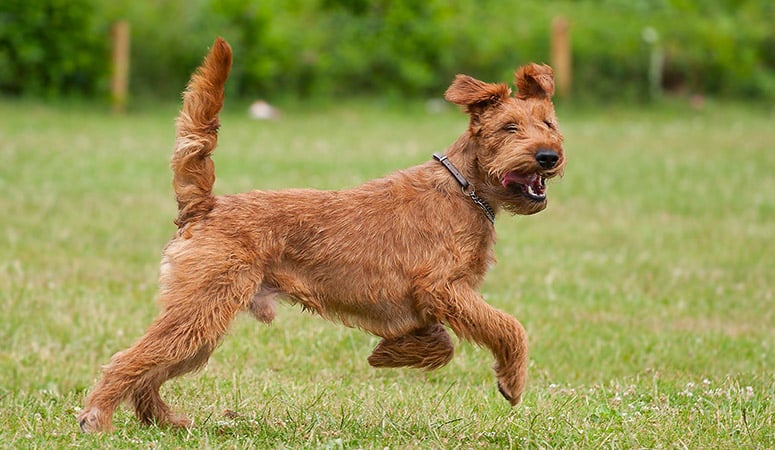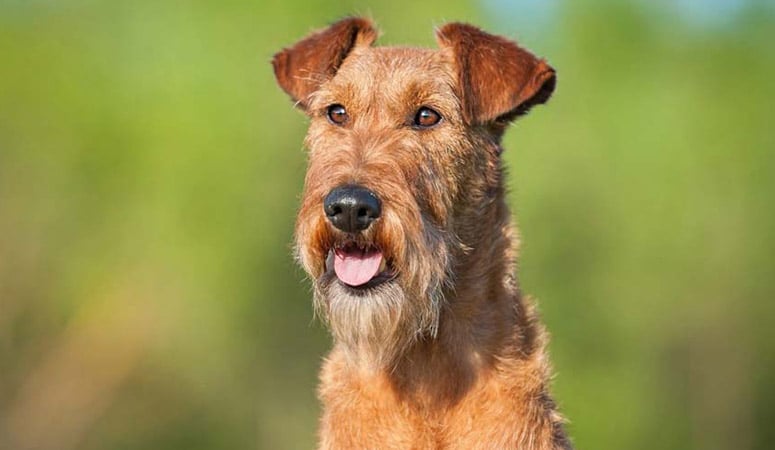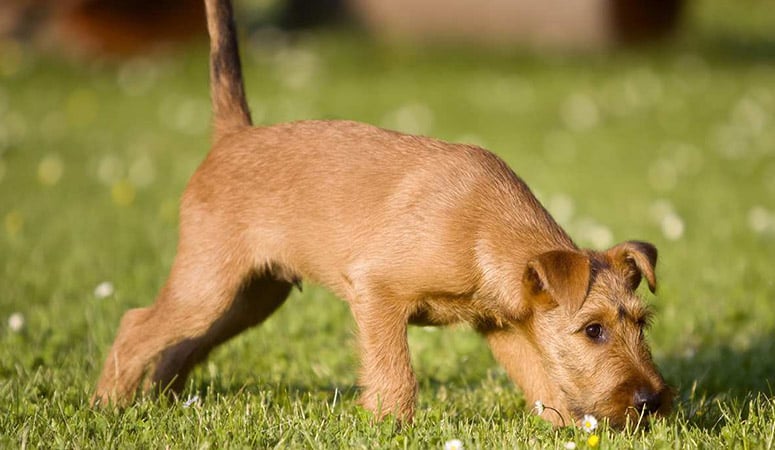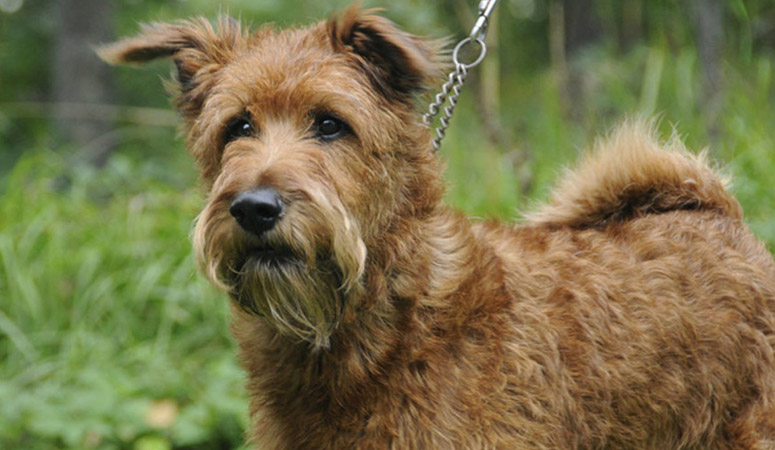Irish Terrier
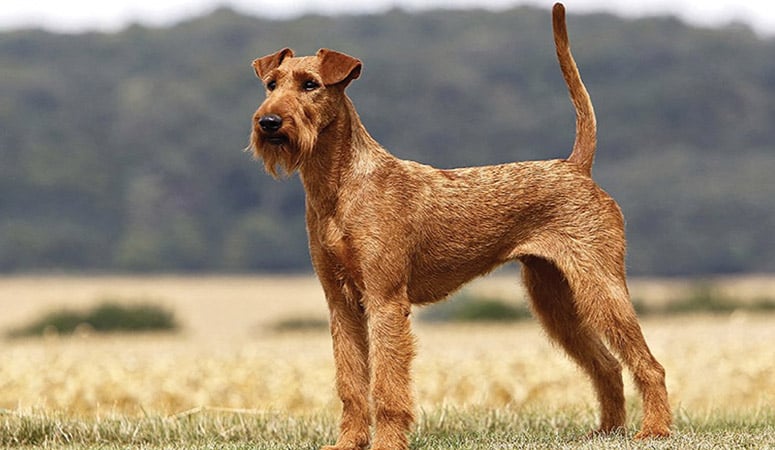
The Irish Terrier has a graceful, racy outline, with a moderately long body. Combined speed, endurance, agility, and power, the IT is an all-round terrier that excels in a great variety of jobs, such as a human companion, watchdog, and advanced training, and they are very loyal to their family.
| Other Names | Irish Red Terrier |
| Color | Red, Red Wheaten, Wheaten |
| Height | Males: 18-19 inches. Females: 18-19 inches. |
| Weight | Males: 26-28 pounds. Females: 24-26 pounds. |
| Life Span | 13-15 years |
| Personality | Bold, Dashing, Tenderhearted |
| Exercise | Regular Exercise |
| Origin |
| Popularity | #119 |
| Groom Needs | Occasional |
| Kids Friendly | Yes |
| Dog Friendly | No |
| Watch Dog | |
| Family Dog | |
| Litter Size | 4-6 |
Irish Terrier Pictures
Irish Terrier Video
Introduction
Considered one of the oldest terriers to exist, the Irish Terrier is a breed of sophisticated and active dogs, swifter on the chase when compared to the Fox Terrier although lacking in substance. Irish Terriers are bred in solid colors of wheaten, red wheaten, or dark red, usually with a patch of white around the chest. Dark red varieties are more common, and their dense and wiry coat helps to protect the dog from the elements of harsh weather.
Dashing and bold Irish Terriers are medium-sized dogs, standing at a full height of 17- 20 inches from shoulder to paw. A well-fed member of the breed would likely weigh around 25-27 pounds, with females generally being a few points lighter than the males. Irish Terriers live to an impressive 12-15 years of service on the average.
Living with Irish Terrier
The Irish Terrier requires brushing every week with a natural bristle brush to keep it clean and healthy. And the owner needs to strip it by hand a couple of times a year to keep the hard texture and bright color. It is important to ensure that brushing out the longer hair on your dog’s legs and face to prevent knots.
Besides, brush your dog’s teeth several times a week to keep fresh breath and prevent gum disease. And check and clean the ears on a weekly basis for dirt, redness, or a bad odor that may indicate an infection. Last, trim the nails as needed, usually once every week or two.
Lively, playful, and outgoing, the Irish Terrier possesses abundant energy, but he doesn’t need tons of exercise. An hour or two of daily physical activity is recommended for a healthy Irish Terrier. There are great options for your dog to exercise, such as a good, brisk walk every day and a trip to the dog park for rip-roaring fun every week, and running in a securely, fenced backyard is ideal as this breed enjoys running. The Irish Terrier is a good companion for joggers who go at easy to moderate pace.
They are eager to please their owners and they can excel as a show dog and performance dog. Besides, they are intelligent and athletic, they can participate in canine sports, such as obedience, agility, rally, earthdog, and flyball.
Generally, it is recommended to feed the Irish Terrier with one to one and a half cups of high-quality dry dog food every day, divided into two meals. And there should be clean and fresh water at all times. More importantly, the food amount should depend on the dog’s weight, size, age, and activity level.
Some dogs are easy to get overweight, so you need to watch their calorie consumption and weight level all the time. Treats may be an important aid in training, but excessive intake can lead to obesity. Also, owners need to distinguish which human food is safe for dogs and which are not. If you have any problems with your dog’s weight or diet, just consult from your veterinarian.
Irish Terriers are prone to the following health conditions: hyperkeratosis, a thickening of the paw pads; melanoma; hypothyroidism; cataracts; urinary stones; eye conditions, including progressive retinal atrophy and cataracts; muscular dystrophy, in rare instances; etc.
Major concerns: none
Minor concerns: urinary stones
Occasionally seen: hypothyroidism, cataract
Total Annual Cost: $2889
Cost is estimated for the first year and may vary depending on many factors, such as dog food, health care, leash, collar, licensing, possible fencing, crates, training and obedience classes, dog-walking, grooming, treats, toys, flea, tick, and heart-worm meds, microchips, etc.
Strong-willed and independent, Irish Terriers are known to avoid training although they are very smart and willing to please. It is required creativity, firmness, and positive reinforcement in the form of praise, play, and food rewards when training the Irish Terrier. This breed is sensitive and won’t respond well to harsh treatment, and gentle, but firm training is the way to a well-behaved, biddable IT.
And it is suggested to start early and consistent socialization and basic obedience training to help Irish Terrier be a well-mannered and adjusted adult. Besides, put And it is suggested to start early and consistent socialization and basic obedience training to help Irish Terrier be a well-mannered and adjusted adult.
History
As the name suggests, the Irish Terrier (IT) was developed in Ireland some hundred years ago. They are believed to be one of the oldest terrier breeds in history and have existed long before they were first exhibited at a dog show in 1873. Consequently, the specific origin of this breed is yet to be determined with certainty. Some believe that the breed had originated in Ireland from the black and tan terrier dog types, much like the Irish Soft-haired Wheaten Terrier which shares a similar national heritage. However, there are assumptions that the Irish Terrier could be a descendant of the Irish Wolfhound
Being highly adaptable creatures, the Irish Terriers hastily assumed a variety of functions in the farms, home, and in the wild. They had exceptional ratting ability no doubt, excellent at exterminating vermin, but these small dogs earned their feeds mainly as versatile dogs up from the earliest part of the 18th century. Irish Terriers served as watchdogs, guard dogs, companion dogs, etc.
It was at a Dublin dog show in 1873 that the Irish Terrier was first separated into a class of its own. Before then, it was classified underdog groups that weighed below or above 9 pounds. Subsequently, members of the breed were collected from different parts of Ireland. By 1879, a breed club was formed in Dublin. The breed went on to be the first terrier dog breed from Ireland to be recognized by the Kennel Club. The American Kennel Club (AKC) recognized this breed in 1885. They are more popular in their home country than in other parts of the world.
Helpful Information
Breed Club: IRISH TERRIER CLUB OF AMERICA
Breed Club Link: http://www.itca.info/
Breed Club Rescue:
Breed Club Rescue Link: https://itca.info/rescue/

